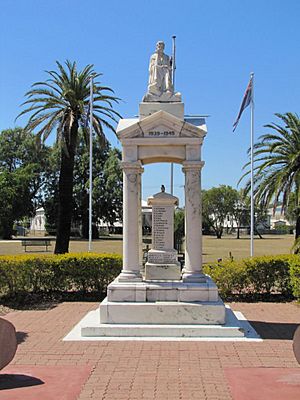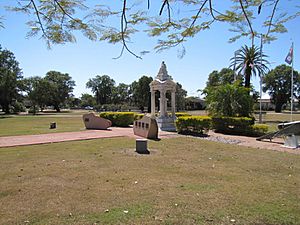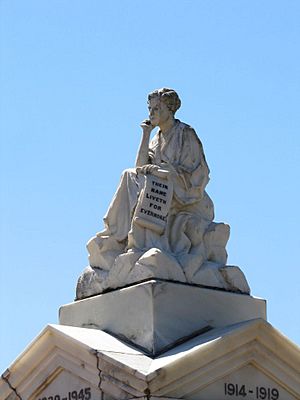Weeping Mother Memorial facts for kids
Quick facts for kids Weeping Mother Memorial |
|
|---|---|

Weeping Mother Memorial, 2012
|
|
| Location | Hickey Street, Gatton, Queensland, Australia |
| Design period | 1919 - 1930s (interwar period) |
| Built | 1922 |
| Architect | F. Williams & Co |
| Official name: Weeping Mother Memorial | |
| Type | state heritage (landscape, built) |
| Designated | 21 October 1992 |
| Reference no. | 600511 |
| Significant period | 1922-(social) 1922 (historical, fabric) |
| Significant components | war trophy/ies, park / green space, trees/plantings, flagpole/flagstaff, memorial - mausoleum, pathway/walkway |
| Builders | F Williams & Co (Ipswich) |
| Lua error in Module:Location_map at line 420: attempt to index field 'wikibase' (a nil value). | |
The Weeping Mother Memorial is a special monument in Gatton, Queensland, Australia. It was built in 1922 to remember soldiers from World War I. A company called F. Williams & Co designed and built it. This memorial is so important that it was added to the Queensland Heritage Register in 1992.
Contents
The Story of the Memorial
The Gatton Weeping Mother Memorial was created by Frank Williams, a skilled stone worker from Ipswich. This beautiful marble monument honors 68 local men. These brave men died during the First World War.
People in the community raised over £500 to build the memorial. This money came from public donations. A special committee was formed to manage the project. Richard James, the committee's chairman, laid the first stone on 22 April 1922. The Governor of Queensland, Sir Matthew Nathan, officially opened the memorial on 14 November 1922.
In 1933, a light was added to shine on the statue at night. The Gatton RSL and Women's Auxiliary helped with this. Nurse Pollock, who was a nurse in the First World War, turned on the light on Armistice Day.
Before the First World War, Australia did not have many public monuments. The memorials built after this war became our first national monuments. They showed the huge impact the war had on a young country. Australia lost 60,000 people from a population of about 4 million. This meant one in five of those who served died. No other war has affected Australia so much.
Even before the war ended, people started building memorials. They were a way to show the nation's sadness. For those who built them, these memorials were as important as graves. They were like substitute graves for Australians whose bodies were buried in battlefields far away. The word "cenotaph," often used for war memorials, means "empty tomb."
Australian war memorials are special because they don't just remember the dead. Australians were proud that their first big army was made of volunteers. These men were honored whether they died or not. Many memorials honor everyone from a town who served, not just those who died. This helps us understand how much communities were involved in the war.
Australian war memorials also show us about loyalty to the British Empire and to Australia. They show the skills of local stone workers, metalworkers, and architects. In Queensland, statues of soldiers were very popular for memorials. In southern states, tall, thin monuments called obelisks were more common.
Many First World War monuments have been updated to include later conflicts. Some have been moved or repaired in ways that changed their original look. The Gatton memorial is unique and very emotional in its design. When its first stone was laid, people said it showed sympathy for the mothers of fallen soldiers.
What the Memorial Looks Like
The First World War Memorial is in a park. It is surrounded by large, old trees.
The memorial is in a newer landscaped area. This area has paved paths and garden beds with new plants. A path from Hickey Street leads to the memorial. There is a bottle tree along this path. New sandstone slabs with bronze plates are on both sides of the path. These remember soldiers from later wars.
The paths form a cross shape, with the monument in the middle. A gun, or "war trophy," is behind and on each side of the monument. A flagpole stands to one side.
The monument itself stands on a concrete base. Above this are two smooth marble steps. The first step is square. The top step curves inward at the center of each side.
Above this base is a structure that looks like a small building. It has four columns and a roof. The floor inside has black and white marble tiles in a checkerboard pattern. A central square pillar rises from this floor. This pillar sits on two steps and is partly covered with a draped cloth. It has the names of the 68 local men who died in the First World War. The names of those who died in later wars are on the base of the pillar. This includes 23 from World War II and 2 from the Vietnam War.
Columns stand at each corner of the pillar. They have simple bases and a decorative pattern called "egg-and-dart" at the top. These columns hold up a roof-like structure. This roof sits on square blocks at each corner. A curved fascia connects these blocks. The roof structure has a triangular top part, called a pediment, on each side. The dates 1939 - 1945 are on the front. In the center of the roof is a square base with a pile of rocks. On top of this is a statue of a weeping mother. She is about two-thirds life-size. Her chin rests on her right hand. She holds a scroll that says, "Their names liveth forevermore."
The monument is made from different types of marble. The statue of the mother is made of a rougher marble called Ulam Marble. Finer marble with grey lines is used in other areas, like the columns and base. Black marble is used on the floor.
Why This Memorial is Important
The Weeping Mother Memorial was added to the Queensland Heritage Register on 21 October 1992. It met several important requirements.
Showing Queensland's History
War memorials help us understand Queensland's history. They show a common event that affected most communities. They also show a time when there was strong Australian patriotism and national pride. This was especially true during and after the First World War.
A Unique Design
The design of this memorial is very rare in Queensland. It might even be unique in all of Australia.
A Great Example of a Memorial
This monument is a good example of a memorial from the time between the two World Wars. It shows what people liked in art and design back then. The Gatton memorial is a lasting record of a major historical event. It uses suitable materials and design elements to do this.
Beautiful and Well-Made
The memorial is important because it is beautiful. It is a landmark in the area. It also shows very high quality workmanship and design.
Important to the Community
This memorial has a strong and ongoing connection with the community. It reminds people of a major historical event. It is also a central place for remembering that event. It is also a great example of the work of the stone worker and sculptor Frank Williams.



